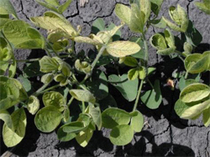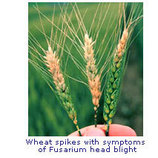
Quick Links

What's New
Petroleum News
Click above to read informational articles about Agland's energy products.
Read about Cenex Total Protection Warranty here!
Agronomy
Central
Click above to read seasonally relavent articles written by Agland's
Agronomy staff.
past agronomy central articles
Resistant kochia
south dakota agronomy topics
Plant nutrient deficiency symptons
Iron Chlorosis
Iron chlorosis happens to many plants. It is very common in landscape plants such as trees, flowers and grass.
Here we see it in soybeans. It can be a yield robber and even a plant killer. It is common this time of year. It's a soil condition that is not easy to treat. Our most common approaches are:
1) Variety Selection for resistance
2) In furrow seed treatment of an iron chelate product, or
3) Foliar treatment
A foliar treatment is your only option left at this time of year.
At Agland Coop we are trying this on one field. It's kind of spendy and it has to be treated twice, a week apart. It can not be applied with your herbicide. It takes 2 extra trips.
Risk map for fusarium head blight
It will soon be time to decide whether or not to treat for head scab on wheat. The wheat pictured is too late for treatment. There is a small window of time for treatment. Click HERE to see the map for Fusarium Head Blight (Head Scab) risk. Call Parkston or A&D Agronomy for your treatment needs.
Jason weber discusses alfalfa weevil
Evaluating corn and soybean stands
Leafy spurge
Jason Weber Talks about jump start
Winter Wheat Stand Evaluation
Interview with Dr. Ron Gelderman, Soil Specialist from SDSU
Agland Employees Attend Commercial Pesticide Certification Seminar
While at Commercial Pesticide Certification Seminars, Roger Barrick caught up with SDSU Extension Field Specialist in Weed Management, Mark Rosenberg. In this video, Mark discusses weed management.
Agland Employees Attend Commercial Pesticide Certification Seminar
Laura Edwards, Extension Climatology Field Specialist for SDSU was on hand at the seminar. Here, she takes a few minutes to discuss weather patterns and the CoCoRaHs program with Agland's Roger Barrick.
Agronomy Team attends training seminar
Members of Agland's agronomy team recently attended a training with soil testing company Agvise and the MZB Mapping Center. Watch this video to learn more.
Purdue University's Corny News Network
Here is information on corn. The website from Purdue University has everything you ever wanted to know about corn. Check it out at Corny News Network.
Top Dressing Nitrogen
By Roger Barrick
12/10/2013
Nitrogen is the most common nutrient top dressed on crops. It can be a dry or liquid application. It is usually not the main supply of nitrogen. Usually the majority of N is broadcast earlier, then the “extra” N put on later. Some of the reasons you might want to top dress include:
-The crop looks great and you had planned for a poor or average crop.
-Top dressing is one way to add protein to a wheat crop.
-You have sandy soil and didn’t want to put all your N out at once in case it leached away. (That’s one reason we use Nutrisphere to protect our nitrogen fertilizer).
-We can follow our same tracks as herbicide and fungicide applications.
Top dress fertilizer can be applied dry with our pull behind fertilizer spreaders, or we can apply it with one of our sprayers set up with the stream bar. The most common crops that Agland producers top dress nitrogen on are their wheat or corn crops.
Check Stored Grain
By Roger Barrick 12/3/2013
What do you do after the grain is in the bin? It a good idea to keep an eye on it. Grain should be kept at a temperature similar to the outside temperature to prevent condensation. So by this time of the year you will want it cooled below 50 degrees, maybe 40 later on. Below 50 degrees insects are not active. They don’t eat, breathe, or reproduce. Cooled and dried, you can keep the grain quite a while. The wetter and warmer the grain is, the less time you can safely store it.
NDSU has very good information on grain storage and drying. Just search for NDSU Grain Storage or NDSU Grain Drying.
Give us a call at either Agronomy Center.
Soil Testing Improves Profit
By Roger Barrick
How do you decide how much fertilizer to apply? For most crops, the correct answer is to take a soil sample and have it analyzed for nutrients already present in the soil. Then supplement that with nutrients the crop will need for your yield goal.
You don’t want to be spending money you don’t have to, but you want to provide the crop with all it needs to make you more money. You should sample every time before you plant a crop that can’t make its own nutrients. Some other crops like grass and alfalfa should also have a soil test occasionally. Our most limiting nutrients are usually nitrogen, phosphorus and potassium. In our area, sulfur and zinc are sometimes limiting. Many other nutrients and properties are analyzed in the standard test.
At Agland Coop we can take these samples for you, help you interpret the results, and apply the nutrients for optimum yields. Now is a good time to take your soil samples.








